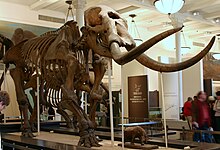American mastodon
| Mastodon Temporal range: Late Miocene - , 5.3–0.011 Ma |
|
|---|---|
 |
|
| Mounted M. americanum skeleton (the "Warren mastodon"), AMNH | |
| Scientific classification | |
| Kingdom: | Animalia |
| Phylum: | Chordata |
| Class: | Mammalia |
| Order: | Proboscidea |
| Family: | †Mammutidae |
| Genus: |
†Mammut Blumenbach, 1799 |
| Type species | |
|
†Elephas americanum Kerr, 1792 |
|
| Species | |
 |
|
| The inferred range of Mammut | |
| Synonyms | |
Mastodons (Greek: μαστός "breast" and ὀδούς, "tooth") are any species of extinct mammutid proboscideans in the genus Mammut, distantly related to elephants, that inhabited North and Central America during the late Miocene or late Pliocene up to their extinction at the end of the 10,000 to 11,000 years ago. Mastodons lived in herds and were predominantly forest dwelling animals that fed on a mixed diet obtained by browsing and grazing with a seasonal preference for browsing, similar to living elephants.
M. americanum, the American mastodon, is the youngest and best-known species of the genus. They disappeared from North America as part of a mass extinction of most of the , widely presumed to have been related to overexploitation by Clovis hunters, and possibly also to climate change.
The first remnant of Mammut, a tooth some 2.2 kilograms (5 lb) in weight, was discovered in the village of Claverack, New York, in 1705. The mystery animal became known as the "incognitum". The first bones to be collected and studied scientifically were found in 1739 at Big Bone Lick State Park, Kentucky, by French soldiers, who carried them to the Mississippi River, from where they were transported to the National Museum of Natural History in Paris. Some time later, similar teeth were found in South Carolina, which, according to the slaves, looked remarkably similar to those of African elephants, soon followed by discoveries of complete bones and tusks in Ohio; people started referring to the "incognitum" as a mammoth, like the ones that were being dug out in Siberia. Anatomists noted that the teeth of mammoth and elephants were different from those of the "incognitum", which possessed rows of large conical cusps, indicating that they were dealing with a distinct species. In 1806 the French anatomist Georges Cuvier named the incognitum "mastodon".
...
Wikipedia
